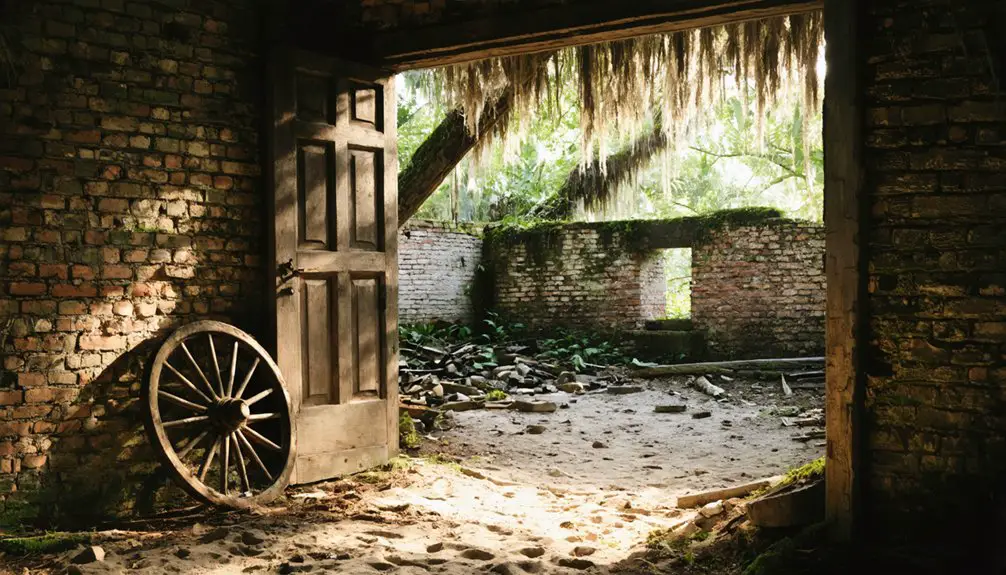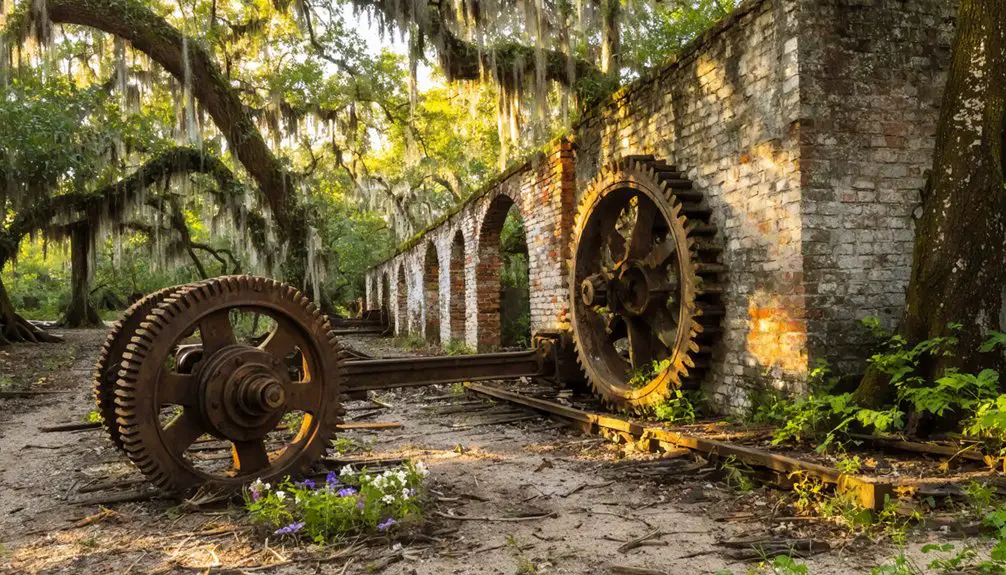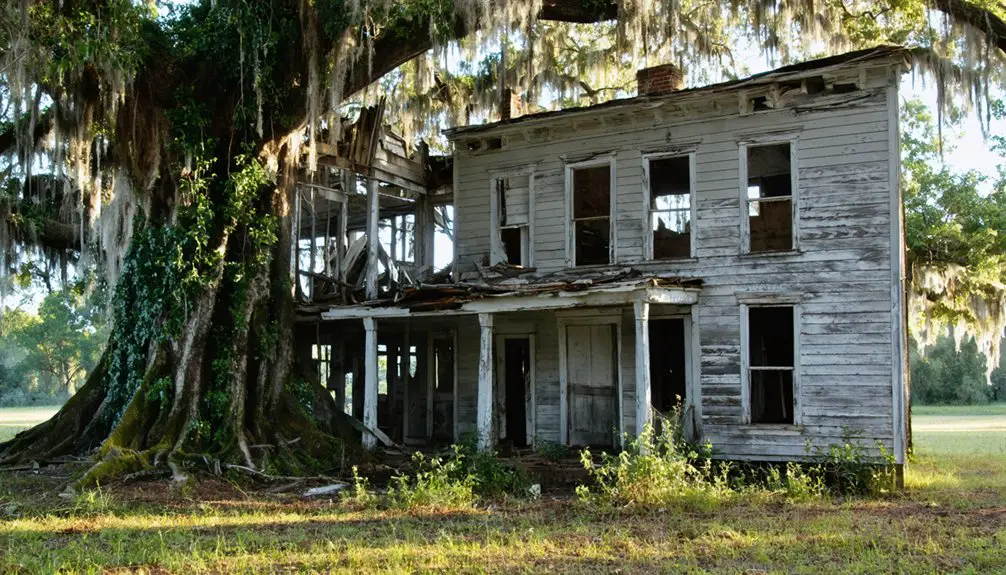You’ll find Fontaine nestled in Florida’s historic landscape, where Timucua Native Americans first settled around 2400 B.C. near healing hot springs. The Spanish arrived in 1513, with Pedro Menéndez de Avilés establishing nearby St. Augustine in 1565. By the late 1800s, Fontaine had transformed into a thriving lumber town, but economic hardships and the Great Depression led to its abandonment in the early 1900s. The town’s ruins hold centuries of untold stories about Native American folklore and colonial mysteries.
Key Takeaways
- Originally a thriving timber town in late 19th century Florida, established near ancient Timucua settlements and the legendary Fountain of Youth.
- Economic decline began in early 1900s due to timber industry collapse, worsened by the Great Depression and mass migration.
- Natural disasters, high insurance costs, and bypassed transportation routes led to widespread property abandonment and business closures.
- Archaeological evidence includes structural foundations, ceramic fragments, and over 4,000 burial sites from Timucua and Spanish colonial periods.
- Site preservation faces challenges from Florida’s harsh climate, water-logged soil, and lack of formal protection or preservation funding.
Origins and Settlement
Before European explorers arrived in what would become Fontaine, the Timucua Native Americans had inhabited the region since 2400 B.C., establishing settlements from Central Florida to Southwest Georgia.
The Timucua lifestyle centered around federated tribes that shared a common language but maintained independent political structures. You’ll find that they both traded and fought among themselves, creating a dynamic pre-colonial society. The tribe had established a one mile radius settlement at what would become known as the Fountain of Youth.
When Juan Ponce de León first spotted the area in 1513 during the Easter Festival of Flowers, Spanish exploration of the region began in earnest. Archaeological evidence shows the area contained healing hot springs that the natives used for medicinal purposes.
He named it “La Florida” and came ashore near a Timucua village called Seloy. Later, in 1565, Pedro Menéndez de Avilés established St. Augustine at Seloy, marking one of the earliest European settlements in North America.
The Rise and Peak Years
During the late 19th century, Fontaine transformed from a modest frontier settlement into a bustling timber town, as entrepreneurs capitalized on the region’s vast pine forests. The town’s timber prosperity soared with the arrival of railroads, enabling efficient transport of lumber and turpentine to broader markets. Similar to the Spring of Eternal Hope, locals claimed their pristine water sources held mystical properties.
You’d have witnessed a thriving community where wood-frame houses dotted the landscape, and general stores, saloons, and service businesses lined the streets. Like many Florida settlements, Fontaine engaged in a constant struggle against encroaching jungle vegetation.
The town’s community resilience showed through its developing social institutions – churches, schools, and volunteer fire departments brought residents together.
Workers and their families flocked to Fontaine, drawn by abundant job opportunities in the mills and forests. Local infrastructure expanded to support daily life, while cultural bonds with neighboring towns strengthened through trade and social interaction.
Economic Decline and Abandonment
As economic hardships swept through Fontaine in the early 1900s, the town’s once-vibrant timber economy began to crumble. The Great Depression worsened the already dire situation.
You’d have witnessed widespread economic migration as residents sought opportunities elsewhere, leaving behind their homes and businesses. Housing affordability plummeted while operating costs soared, pushing both homeowners and renters to abandon their properties.
Natural disasters dealt additional blows to Fontaine’s struggling economy. Insurance premiums skyrocketed, particularly after repeated storm damage, making property ownership financially unsustainable. The days on market tripled as properties sat vacant, mirroring the modern crisis in cities like Northport.
Local businesses shuttered their doors as transportation routes bypassed the town, further accelerating its decline. The final nail in the coffin came when investors and developers withdrew, leaving partially completed projects and vacant lots as silent testimonies to Fontaine’s economic collapse.
Myths and Local Legends
While the Fountain of Youth legend captivated European explorers for centuries, Fontaine’s local myths emerged from a rich tapestry of Native American and colonial influences.
The town’s folklore intertwines Timucua beliefs with Spanish colonial narratives about mythical waters that could restore youth and liveliness. Ancient sacred springs and waters were revered by civilizations like the Egyptians, Sumerians, and Babylonians long before European contact. The Arawak people described it as a land of prosperity, which Spanish explorers later associated with eternal youth.
You’ll find that the area’s supernatural reputation stems from reported ghostly encounters near abandoned colonial structures and Native American burial grounds.
Though Ponce de León never explicitly sought the fabled fountain in his writings, tourism promoters later embraced these tales, particularly after Florida joined the United States in 1819.
The surrounding wilderness adds to Fontaine’s mystique, where natural phenomena are often interpreted through a supernatural lens, creating an enduring legacy of local legends that persist despite historical evidence suggesting otherwise.
Natural Forces and Environmental Impact
You’ll find natural forces played a decisive role in Fontaine’s abandonment, as Florida’s humid subtropical climate accelerated the decay of structures while thick vegetation steadily reclaimed the settlement.
Like rising sea levels in Vunidogoloa, Fiji, the rising water table and unstable soil conditions undermined building foundations and infrastructure, making it increasingly difficult to maintain permanent structures in the swampy terrain.
The proximity to Old Kings Road provided little protection from the elements despite its historical significance.
Devastating hurricanes and coastal storms repeatedly battered the area, causing flooding and saltwater intrusion that ultimately convinced remaining residents to seek more stable ground.
Weather’s Role in Decline
The devastating combination of tropical storms and hurricanes played a central role in Fontaine’s eventual abandonment.
You’ll find evidence of how intensifying weather patterns repeatedly battered the settlement’s infrastructure, washing away roads and homes with relentless storm surges. The community’s limited resources couldn’t keep pace with the constant repairs needed after each severe weather event.
As climate shifts brought more frequent and powerful storms to Florida’s coast, Fontaine’s vulnerability became increasingly apparent.
The punishing combination of wind damage, flooding, and soil erosion made it impossible to maintain stable structures. Salt-laden storm surges contaminated local soil and freshwater sources, while hurricane-force winds stripped away vegetation that once protected the settlement from coastal forces.
Rising Water Table Impact
Beyond the immediate threat of storms and hurricanes, rising groundwater levels posed a persistent challenge to Fontaine’s survival.
You’ll find evidence of the town’s losing battle with water in its deteriorating foundations and waterlogged ruins. The groundwater impacts were relentless – steadily rising water tables saturated the soil year-round, not just during storms.
As the water table crept upward, it wreaked havoc on Fontaine’s infrastructure. The flooding risks intensified as structures succumbed to rot, while foundations weakened in the constantly saturated soil.
The moisture invited aggressive vegetation growth that further destabilized buildings. Even the surrounding landscape transformed as wetland plants invaded previously dry areas, and springs altered their ancient flow patterns, gradually erasing traces of human habitation.
Hurricane and Storm Damage
While rising groundwater steadily eroded Fontaine’s foundation, violent hurricanes and storms dealt devastating blows that accelerated the town’s decline.
Hurricane-force winds exceeding 130 mph ripped through the region, destroying homes and uprooting trees. Storm surges of up to 18 feet inundated coastal areas, while torrential rains dumped over 14 feet of floodwater in neighborhoods, overwhelming local hurricane preparedness efforts.
The compound effects proved catastrophic. Saltwater intrusion damaged soil and freshwater sources, while hurricane-spawned tornadoes created scattered zones of destruction.
Storm recovery became increasingly difficult as each disaster compounded the damage from the last. Standing water led to structural deterioration, and repeated strikes eventually crippled local industries.
The relentless assault of these natural forces ultimately pushed Fontaine toward abandonment.
Archaeological Findings

You’ll find limited archaeological evidence at Fontaine’s ghost town site, where surface surveys have revealed only scattered structural foundations and minimal artifacts due to extensive environmental degradation.
Modern development and natural erosion have greatly impacted researchers’ ability to conduct thorough archaeological investigations of the settlement’s remains.
The site’s challenging survey conditions stem from decades of soil displacement and vegetation overgrowth, making it difficult to establish precise chronological markers for the town’s brief existence.
Minimal Surface Discoveries
Although surface-level archaeological discoveries in Fontaine remain limited, excavations since 1934 have revealed significant evidence of both Timucua and Spanish colonial presence.
You’ll find minimal artifacts scattered across the 15-acre site, yet they tell a compelling story of cultural intersection. The discovery of over 4,000 burials marks the area’s historical significance as one of America’s earliest sites of Christianized indigenous internments.
While 20th-century development has disturbed some archaeological layers, you can still trace evidence of raised pathways and original infrastructure linked to the 1565 Menendez fort.
The site’s most notable finds include ceramic fragments, hunting tools, and 16th-century European metal items, demonstrating the complex relationship between Timucua villagers and Spanish settlers.
Site Survey Challenges
Archaeological investigations at Fontaine face significant physical and logistical hurdles that shape excavation methods and findings.
You’ll find excavation difficulties stem from water-logged soil conditions near Hospital Creek and marshy lowlands, while 20th-century roadbeds and refuse pits have disrupted key archaeological layers.
The site’s stratigraphic complexities present unique challenges, with multiple overlapping occupation phases between Spanish colonial and Native American settlements.
You’re dealing with dense clusters of indigenous burial sites, including America’s earliest Christianized native burials, which require careful separation from habitation debris.
Modern landscape modifications and ongoing park activities have limited access to certain areas, while previous surface clearing has disturbed original deposits.
The discovery of over 90 Native American skeletal remains demands specialized excavation approaches to respect cultural sensitivities.
Preservation Efforts and Current Status
Despite its historical significance as a Florida ghost town, Fontaine currently lacks formal preservation protections or organized advocacy efforts.
You won’t find it on prominent historic preservation lists like Florida Trust’s “11 to Save,” and there’s no state-level cultural landmark status to safeguard its remains. Without preservation funding or community engagement, the site faces mounting challenges from Florida’s harsh climate and structural decay.
The absence of local grassroots advocates or resident-led preservation campaigns has left Fontaine particularly vulnerable.
While no immediate development threats have emerged, you’ll find the ghost town susceptible to the same pressures that affect other historic sites in Florida’s coastal areas. The deteriorating structures continue to weather time and elements without emergency repairs or stabilization efforts.
Legacy in Florida’s History

When you trace Fontaine’s legacy in Florida’s history, you’ll find a quintessential example of 19th-century rural settlement patterns and economic vulnerabilities.
The town’s cultural significance extends beyond its physical remains, representing the broader story of pioneer communities that flourished briefly before succumbing to economic and environmental challenges.
Historical narratives of Fontaine showcase the delicate balance between human ambition and natural forces, particularly evident in stories surrounding the Big Freeze of 1894-1895.
You’ll discover how transportation changes, including shifted railroad routes, sealed the town’s fate.
Today, Fontaine’s story serves as a powerful reminder of Florida’s dynamic past, where communities rose and fell based on economic forces, environmental pressures, and changing transportation patterns.
Its legacy continues to inform studies of rural development and decline in Florida’s historical landscape.
Frequently Asked Questions
Are There Any Surviving Photographs of Fontaine During Its Inhabited Years?
You won’t find any confirmed photographs from Fontaine’s inhabited period in historical archives. Despite extensive searches through photographic evidence collections, no surviving images have been definitively identified from its active years.
What Native American Tribes Originally Lived in the Fontaine Area?
Like shells layered in ancient middens, the Timucua people were your area’s first inhabitants, with archaeological evidence showing they’d established villages near Fontaine’s springs since 2400 B.C.
Did Any Famous Historical Figures Ever Visit or Stay in Fontaine?
You won’t find any documented famous visitors or historical events involving notable figures in Fontaine. Unlike nearby St. Augustine, which attracted explorers and governors, there’s no evidence of any prominent personalities ever staying there.
What Was the Maximum Recorded Population of Fontaine at Its Peak?
While there’s no officially recorded count, historical evidence suggests you’re looking at a peak population between 200-500 residents during the lumber town’s height, before it became Florida’s latest ghost town.
Were There Any Churches or Cemeteries Established in Fontaine?
You won’t find any documented church history or cemetery significance in this location. Historical records and ghost town surveys don’t show evidence of established churches or burial grounds being present.
References
- https://www.journaloffloridastudies.org/0102ghosttowns.html
- https://www.youtube.com/watch?v=8QapC-yk4Bo
- https://www.newspapers.com/article/the-courier-journal-fontaine-ghost-town/40200226/
- https://www.floridashistoriccoast.com/things-to-do/history/fountain-youth/
- https://en.wikipedia.org/wiki/Fountain_of_Youth
- https://www.fountainofyouthflorida.com/history/
- https://www.legendsofamerica.com/fl-fountainyouth/
- https://www.ghostsandgravestones.com/st-augustine/fountain-of-youth
- https://www.trolleytours.com/st-augustine/fountain-of-youth
- https://www.youtube.com/watch?v=qCbv1ZowDoA



